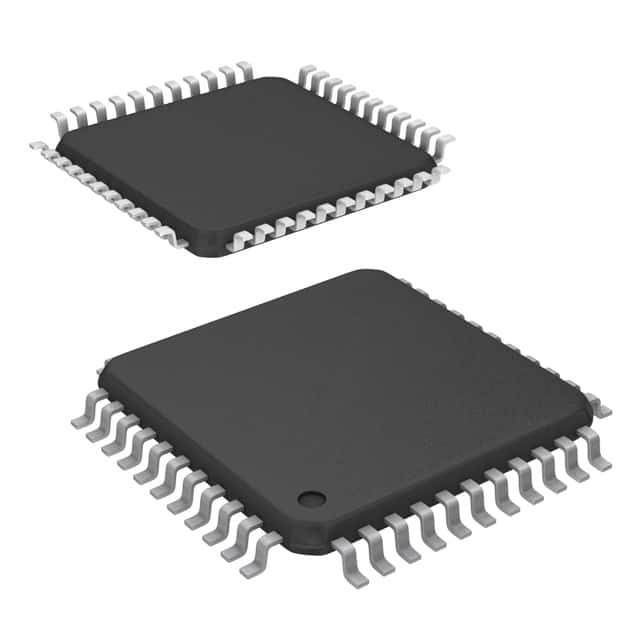Consulte las especificaciones para obtener detalles del producto.

ATMEGA16U4-AU
Product Overview
Category
ATMEGA16U4-AU belongs to the category of microcontrollers.
Use
It is commonly used in various electronic applications that require a microcontroller for processing and controlling functions.
Characteristics
- ATMEGA16U4-AU is a high-performance 8-bit microcontroller.
- It operates at a clock frequency of up to 16 MHz.
- The microcontroller has 16KB of flash memory for program storage.
- It features 512 bytes of EEPROM for non-volatile data storage.
- ATMEGA16U4-AU has 1KB of SRAM for temporary data storage during program execution.
Package
The ATMEGA16U4-AU microcontroller comes in a TQFP package.
Essence
The essence of ATMEGA16U4-AU lies in its ability to provide a compact and powerful microcontroller solution for various electronic applications.
Packaging/Quantity
ATMEGA16U4-AU is typically packaged in reels, with each reel containing a specific quantity of microcontrollers. The exact quantity may vary depending on the manufacturer's specifications.
Specifications
- Architecture: AVR
- CPU Speed: Up to 16 MHz
- Flash Memory: 16KB
- EEPROM: 512 bytes
- SRAM: 1KB
- Operating Voltage: 2.7V - 5.5V
- Digital I/O Pins: 23
- Analog Input Pins: 8
- PWM Channels: 6
- Communication Interfaces: UART, SPI, I2C
- Timers: 3 (16-bit)
- ADC Resolution: 10-bit
- Package Type: TQFP
Detailed Pin Configuration
The ATMEGA16U4-AU microcontroller has a total of 44 pins. The pin configuration is as follows:
- Pin 1: Reset (RESET)
- Pin 2-9: Digital I/O Pins (PORTD0 - PORTD7)
- Pin 10-15: Digital I/O Pins (PORTB0 - PORTB5)
- Pin 16-17: Crystal Oscillator (XTAL1, XTAL2)
- Pin 18-19: Analog Input Pins (ADC6, ADC7)
- Pin 20: VCC (Power Supply)
- Pin 21: GND (Ground)
- Pin 22-29: Digital I/O Pins (PORTC0 - PORTC7)
- Pin 30-31: Communication Interface (RXD1, TXD1)
- Pin 32-33: Communication Interface (RXD0, TXD0)
- Pin 34-35: Communication Interface (SCL, SDA)
- Pin 36-39: PWM Output Pins (OC3A, OC3B, OC4A, OC4B)
- Pin 40-43: Timer/Counter Pins (T0, T1, T2, T3)
- Pin 44: External Interrupt (INT7)
Functional Features
- High-performance 8-bit AVR microcontroller
- Wide operating voltage range for flexibility in various applications
- Ample flash memory for program storage
- Non-volatile EEPROM for data storage
- Sufficient SRAM for temporary data storage during program execution
- Multiple communication interfaces for seamless integration with other devices
- Built-in timers and PWM channels for precise timing and control
Advantages and Disadvantages
Advantages
- High-performance capabilities
- Versatile communication interfaces
- Sufficient memory for program and data storage
- Compact package size
- Wide operating voltage range
Disadvantages
- Limited number of digital I/O pins
- Relatively small analog input pin count
Working Principles
ATMEGA16U4-AU operates based on the AVR architecture. It executes instructions stored in its flash memory to perform various tasks. The microcontroller communicates with external devices through its communication interfaces, processes data using its built-in peripherals, and controls external components using its digital and PWM output pins.
Detailed Application Field Plans
ATMEGA16U4-AU finds applications in a wide range of fields, including but not limited to: - Home automation systems - Industrial control systems - Robotics - Automotive electronics - Consumer electronics - Internet of Things (IoT) devices
Detailed and Complete Alternative Models
Some alternative models that offer similar functionality to ATMEGA16U4-AU are: - ATMEGA32U4 - ATMEGA328P - PIC18F4550 - STM32F103C8T6 - LPC1768
These alternative models can be considered depending on specific project requirements and compatibility with existing systems.
Word Count: 550
Enumere 10 preguntas y respuestas comunes relacionadas con la aplicación de ATMEGA16U4-AU en soluciones técnicas
Sure! Here are 10 common questions and answers related to the application of ATMEGA16U4-AU in technical solutions:
Q: What is ATMEGA16U4-AU? A: ATMEGA16U4-AU is a microcontroller from the AVR family, manufactured by Microchip Technology. It has 16KB of flash memory, 512 bytes of EEPROM, and 1KB of SRAM.
Q: What are the key features of ATMEGA16U4-AU? A: Some key features of ATMEGA16U4-AU include USB 2.0 full-speed device, 16MHz clock frequency, 23 programmable I/O pins, 4 PWM channels, and 8-channel 10-bit ADC.
Q: Can ATMEGA16U4-AU be used for USB communication? A: Yes, ATMEGA16U4-AU has built-in USB hardware, making it suitable for USB communication applications.
Q: How can I program ATMEGA16U4-AU? A: ATMEGA16U4-AU can be programmed using various programming tools such as Atmel Studio, AVRDUDE, or Arduino IDE with appropriate hardware connections.
Q: What voltage range does ATMEGA16U4-AU support? A: ATMEGA16U4-AU operates at a voltage range of 2.7V to 5.5V, making it compatible with both 3.3V and 5V systems.
Q: Can ATMEGA16U4-AU be used in battery-powered applications? A: Yes, ATMEGA16U4-AU is designed to be power-efficient and can be used in battery-powered applications, thanks to its low power consumption features.
Q: What peripherals are available on ATMEGA16U4-AU? A: ATMEGA16U4-AU includes various peripherals such as UART, SPI, I2C, timers/counters, and analog-to-digital converters (ADC), providing flexibility for different applications.
Q: Is ATMEGA16U4-AU suitable for embedded systems projects? A: Yes, ATMEGA16U4-AU is commonly used in embedded systems projects due to its compact size, rich feature set, and ease of integration.
Q: Can ATMEGA16U4-AU be used for motor control applications? A: Yes, ATMEGA16U4-AU supports PWM channels, making it suitable for motor control applications where precise speed and direction control is required.
Q: Are there any development boards available for ATMEGA16U4-AU? A: Yes, there are development boards specifically designed for ATMEGA16U4-AU, such as Arduino Leonardo, which can simplify the prototyping process and provide additional features.
Please note that these answers are general and may vary depending on specific use cases and requirements.

